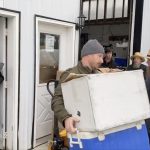Loren Elliott/Getty Images; Dave Mosher/Business Insider; Samantha Lee/Business Insider
- SpaceX, founded by Elon Musk, is working around-the-clock to realize a 40-story Mars rocket system called Starship-Super Heavy.
- The company is developing Starship at its launch site in Boca Chica: a remote, wildlife-rich area at the southeastern tip of Texas.
- But SpaceX took root in July 2014 next to a hamlet of retiree-age homeowners called Boca Chica Village.
- Since SpaceX made its first buyout offer in 2019, most residents have sold to the company. But a sizable group of homeowners have yet to sell.
- Last week, a SpaceX executive claimed to make a week-long “best and final” purchase offer, residents say, while telling some “it’s not safe” and “too dangerous” to live there anymore.
- Meanwhile, the company is trying to turn the area into a private rocket resort for employees, guests, and VIPs. Some residents have vowed not to sell to SpaceX as a result.
- Visit Business Insider’s homepage for more stories.
SpaceX has made what it calls a final attempt to buy out the remaining residents of Boca Chica Village, the 1960s beachside neighborhood at the wildlife-rich southeastern tip of Texas, where Elon Musk’s company is building a private resort to launch rockets.
It comes at a pivotal moment for the company. If it doesn’t work, SpaceX has hinted it may “pursue alternative approaches” to push ahead with its ambitious and increasingly off-script plans for the region.
Musk, SpaceX’s founder and CEO, has described the remote area as vital to developing a 394-foot-tall reusable rocket system called Starship-Super Heavy. If realized, Starship could slash the cost of reaching space a hundredfold and enable routine, relatively affordable access to orbit, the moon, and Mars, along with hypersonic travel around Earth.
But realizing that dream, and building a “resort” for employees and VIPs, could hinge on persuading everyone who still lives in Boca Chica — nearly all of them elderly or retired — to get out of town.
SpaceX attempted a village-wide buyout in September 2019, offering owners what it said was three times the value of their homes based on a company-provided appraisal. Although many residents have protested the deal, calling the valuations “lowball,” “drive-by,” and “crappy,” more than half accepted in the following months. Today, about 10 homes remain, obstinately, unsold.
In hopes of capturing the rest, or maybe teeing up a new plan to deal with villagers, SpaceX last week made what it claimed is a “best and final” offer to remaining residents, company emails shared with Business Insider show.
Dave Finlay, SpaceX’s senior director of finance, also called up some homeowners, as he has done in the past. Before the pandemic, he occasionally visited their houses, bearing chocolates and SpaceX apparel. A few of the remaining residents told Business Insider that Finlay had called them to say “it’s not safe” and “too dangerous” to live there anymore. He gave them a week to take the deal, they said.
But short of offering more money than the three-times-appraisal deal — one that Musk mandated himself, residents said — SpaceX is unlikely to see any more sales.
The company’s offers supposedly expired on Friday with no sales in sight, several residents said, because the terms, almost identical to if not worse than those that came before, wouldn’t come close to getting them a similar home in a similar area.
“There’s just no way in hell we can replace that place,” said Rosemarie Workman, who’s owned a home on Weems Street in Boca Chica since 2004 with her husband, Jim. “And when somebody gives me a one-week notice, it’s a trap,” she said.
“‘You’ll have one week to do this or that, and then we’ll do something else’? That’s a threat in my book.”
SpaceX did not acknowledge Business Insider’s requests for comment, nor has it acknowledged any query from this outlet about its presence in Boca Chica for more than a year.
The timing of SpaceX’s latest home-purchase push is conspicuous and potentially significant given the recent airing of a Vice TV documentary about the site, a crucial Federal Aviation Administration reassessment of the company’s future operations, and Musk’s desire to fly Starships from the site to orbit next year.
Starship’s path to orbit has hit earthbound hurdles
Finlay started calling residents about September 23, or two days after Vice TV debuted an unflattering 45-minute film about SpaceX’s presence in Boca Chica.
It focuses on officials who helped pave the way for SpaceX’s presence in Boca Chica, and locals who’ve lived through the company’s evolving activity there. (“Business Insider Today” produced a short documentary about the project in 2019.)
Musk first looked to Boca Chica as a candidate site for launching rockets in 2011. By July 2014, after scores of quiet property purchases and years of jumping through procedural hoops, SpaceX persuaded the FAA and other federal, state, and local stakeholders to sign off on its 1,576-page plan, titled the SpaceX Texas Launch Site Environmental Impact Statement.
SpaceX said it would operate Boca Chica as the first commercial US spaceport, from which no more than a dozen orbital missions a year would launch using Falcon 9 and Falcon Heavy rockets.
“We’re talking about something that’s really the big leagues here. This would be kind of a commercial version of Cape Canaveral,” Musk said during March 2013 testimony before the Texas House Appropriations Committee. “It’d be an historical first in the world. It would be of very great significance both to the local economy as well as to the world.”
But after two crushing mission failures, and a few years of Musk’s mulling over a fully reusable rocket concept, SpaceX abandoned plans to fly Falcon rockets from Boca Chica.
SpaceX has managed to proceed relatively unhindered because it included permission to launch “a variety of reusable suborbital launch vehicles” with its original environment-impact statement. Though SpaceX’s grain-silo-like prototypes stand about 160 feet tall and 30 feet wide, they’re technically suborbital vehicles.
Now that Musk wants to reach orbit from Boca Chica, however, SpaceX must draw up a new environmental assessment.
“The FAA continues to work with SpaceX to finalize its draft description of its proposed operations,” an agency spokesperson told Business Insider. “The agency does not have an expected date of concluding this action.”
If the reassessment finds Starship operations won’t differ too much compared to old Falcon rocket plans, at least in environmental impact, it may take SpaceX only a few months longer to get a license, and fly Starships into orbit for the first time.
Yet if major differences are found, SpaceX may need to draft a new environmental impact statement. George Nield, who used to head the FAA’s Office of Commercial Space Transportation, previously said that such a report could cost the company one to three years, an eternity in Muskian time.
Boca Chica Village will be a liability to SpaceX until residents are gone
How much Boca Chica residents could materially hinder SpaceX’s future is uncertain. What is known, however, is that fully-fueled Starship-Super Heavy rockets — which may carry 9 million pounds of propellants, or about three times that of a Falcon Heavy — pose a greater potential threat in the event of an accident.
Musk ultimately wants to move launches off-shore for noise and safety, but until that engineering effort produces functional ocean hardware, SpaceX is stuck on land.
Even flights of much smaller and more experimental Starship prototypes have given the company and residents headaches.
For example, SpaceX saw its FAA-mandated launch insurance requirements jump more than thirtyfold, to $100 million, ahead of the second launch of a partly fueled Starhopper Starship prototype. The requirement went up after hazard analyses suggested an extremely rare worst-case scenario had the potential to harm people in the village.
Starhopper’s first launch ignited a large fire in the wildlife refuge surrounding it, ultimately leading to the burning of more than 130 acres, according to a document the US Fish & Wildlife Service sent to the FAA on March 2 and obtained through a Freedom of Information Act request. Aerial images showed the flames came within about 1,000 feet of structures at the eastern edge of the village.
In addition to the residents themselves, homes are a liability. Each one that SpaceX doesn’t own increases the chance that a launch accident could exceed $25,000 in property damage, a threshold that could trigger an investigation by the National Transportation Safety Board.
In communications ahead of Starhopper’s launch in August 2019 between the FAA and SpaceX, which Business Insider obtained through a FOIA request, federal officials reminded the company of these and other facts.
One frequently discussed concern was the risk of a distance focusing overpressure, or DFO event, when a specific combination of atmospheric conditions causes an explosive blastwave to travel more efficiently and shatter windows much farther away.
“The DFO hazards to Boca Chica village exist at any point that the vehicle has a substantial propellant load,” an FAA aerospace engineer told two agency colleagues in an email on August 23, 2019, regarding how and when exactly SpaceX should warn residents about a test launch planned for the following week.
SpaceX had sheriffs hand out warning notices a day before the first attempted launch of Starhopper on August 25. The flyers recommended that residents and their pets go outside their homes about 10 minutes before liftoff to avoid the risk of a flying glass, adding that police sirens would blare at that time.
“In my limited experience with their operations, propellant loading during permitted operations could be far in advance of T -10 minutes. The residents of the village could be at risk for DFO prior to the announcement,” the engineer said.
An FAA colleague responded that the US Air Force should model the blastwave risk throughout fueling, but it’s unclear if that step was taken or, if so, what the data showed. (The FAA did not provide details in time for publication, though the catastrophic explosion of a Starship prototype on May 29 did not appear to shatter any windows in the village.)
SpaceX’s first launch attempt on August 26 was scrubbed, but Starhopper successfully flew about 500 feet into the air and landed on August 27.
Buying out all the residents could prove impossible
Every home in Boca Chica Village is less than two miles from SpaceX’s beachside launch pad. Typically, government launch complexes like NASA’s Kennedy Space Center mandate people to stay a few miles away (and no one lives there).
The village and its residents will almost certainly be considered in SpaceX’s new environmental assessment and, if that goes well, launch licensing. The company, always looking to speed things up, likely sees their permanent removal as the best solution.
“We are working with the residents of Boca Chica Village because … it will end up needing to get cleared for safety a lot of times,” Musk said during a briefing about Starship in September 2019. “I think the actual danger to Boca Chica Village is low, but it’s not tiny. So therefore we went super-tiny risk. So probably, over time, it’d be better to buy out the villagers.”
Instead of confidential private negotiations, SpaceX offered everyone threefold the value of their homes, as determined by appraisers hired by the company. According to some residents, Musk told villagers in a private meeting last year that he dictated those terms because he wanted the deals to be fair and not favor residents with better negotiating skills or resources.
But inequalities arose as Musk later said the appraisal was negotiable, which SpaceX formalized in a letter sent to homeowners on September 26, 2019.
Homeowners who could afford it paid for more expensive appraisers in hopes of boosting their properties’ base values. In some cases, that moved payouts for homes in the area from low hundreds of thousands to about $1 million, said a person close to the matter and known to Business Insider.
Meanwhile, those on fixed incomes settled for a less costly local appraiser who, despite being licensed and in good standing, did not have his valuations accepted by SpaceX. Most of those who didn’t sell had all-in offers from SpaceX worth about $150,000.
In any case, some residents are more bound to the area than SpaceX or Musk seemed to assume.
“I kind of think he thinks money can buy everything, and we should be glad we’re getting the three times, and we should just go,” Mary Bloomer, a part-time resident from Iowa who plans to retire in a Boca Chica home with her husband, Harvey, told Vice TV. “But, no, money can’t buy everything. So here we are.”
Earlier this year, Finlay offered to relocate several such homeowners west down Highway 4 toward Brownsville, and use the proceeds of sales to build them new homes. But the county apparently refused to permit the plan because of a lack of running water. Boca Chicans have nonpotable water trucked out to cisterns monthly, and go to town to buy their drinking water.
With Finlay’s latest approach, relocation was not on the table, nor did SpaceX budge on its rejection of residents’ independent appraisals, which would have more than tripled some payouts, offers reviewed by Business Insider showed.
Instead, residents say Finlay emphasized the finality of the offer and the safety concerns.
Celia Johnson, who’s owned a Boca Chica residence since 1992, said Finlay told her during a phone call on September 25 that “it’s not safe” to live in Boca Chica anymore.
“He said that the FAA … has declared this a hazardous area, and that it extends beyond the village,” Johnson, who has repeatedly declined SpaceX’s offer to buy her property — because of what she described as its “crappy, lowball” and “drive-by” appraisals — she told Business Insider.
A spokesperson for the FAA declined to answer Business Insider’s question about unpublished hazard analyses and instead directed us to existing documents.
Familiar with the environmental-impact statement’s descriptions of clearing the village before launch, Johnson said she’d just leave during launch operations, a procedure that SpaceX told residents years ago would be an option.
“He said, ‘Unfortunately, that is now no longer an option,” Johnson said.
When Business Insider asked the FAA if residents would have to permanently relocate before any Starship-Super Heavy launches, a spokesperson said “no decisions on any future operations have been made.”
What may happen next is unclear, likely even to SpaceX
Boca Chica Village sits within Cameron County, which created the Cameron County Spaceport Development Corporation before SpaceX moved to the area. Residents are aware that the corporation has eminent-domain authority — a government-sanctioned process that can condemn private properties to make way for “public use” developments — though legal experts say any use of that authority could spark a drawn-out battle with no certainty of a win.
A nonprofit libertarian organization called the Institute for Justice has also expressed interest in offering villagers pro bono legal representation, should eminent-domain proceedings begin.
“FAA has not advised SpaceX, and does not advise launch companies, about how to comply with hazard areas,” an administration representative said when asked about its involvement in SpaceX’s efforts to buy Boca Chica homes.
“Unless there are operations that cause full-time danger to the public … then we protect the public only during those operations that are hazardous,” Brigadier Gen. Wayne Monteith, the FAA’s associate administrator for Commercial Space Transportation, said in January.
He added that buying homes is part of SpaceX’s “business case” and not something the FAA has mandated.
While SpaceX pushes to remove residents, it’s been knocking down some of the houses it purchased and remodeling others into employee residences. It’s also used scrap rocket parts to retrofit an old corner store into an outdoor restaurant, a mile and a half from its launch pad.
The improvements join a growing number of Airstream trailers, fire pits, kayaks, and other amenities, all part of an effort to transform the area into a private resort set amid a round-the-clock Mars rocket development and launch facility.
“Aiming to make it super fun!” Musk tweeted in August about the project.
He said the resort would be “mostly for employees,” but added it would “support public access whenever it’s safe & secure.”
Residents said they didn’t understand why they’d have to move when employees would get to take over their homes after they left.
“The houses they bought, they’re not just bulldozing them down. They gut them and redo them, and put lawns in and water-filtration systems in and air-conditioning,” Rosemarie Workman said.
“If it’s not safe to be there, why are they doing this to all those homes?”
Do you have a story or inside information to share about the space industry? Email Dave Mosher, send him a Twitter direct message, or consider more secure communication options listed here.
Powered by WPeMatico






